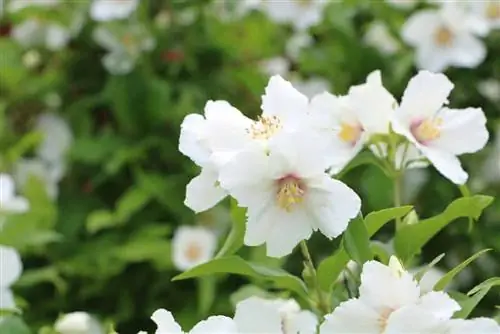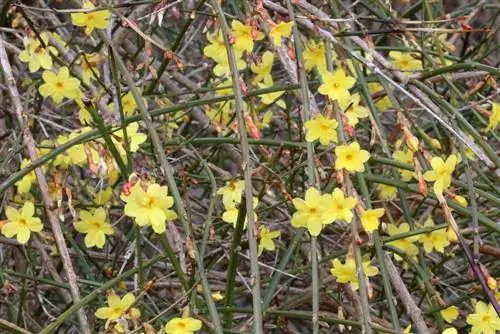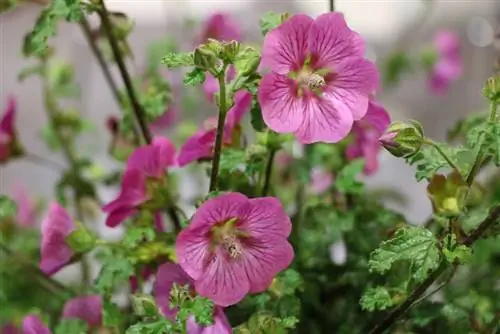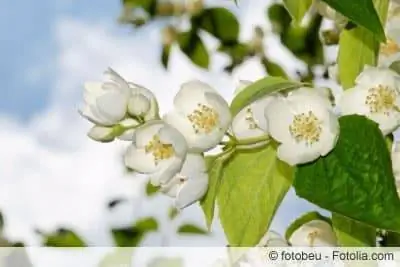- Author admin [email protected].
- Public 2023-12-17 03:39.
- Last modified 2025-01-24 12:45.
Without a doubt, the double garden jasmine has been one of the most popular ornamental shrubs in local gardens for years, because it blooms without much care. The small, double, delicate white flowers also exude an intense and fruity scent in the summer months between June and July. Since the pipe bush grows very wide, it is also good to cultivate as a privacy screen in a hedge or as a terrace border. However, as a solitary plant, the graceful shrub reveals all its beauty.
Location
The stuffed garden jasmine does not place high demands on its location. So it can be sunny to partly shady here. This will allow the shrub to really develop. However, there are many ways in which the pipe bush can be used to its advantage in your own garden and the following locations are also ideal:
- as a solitaire on a meadow
- as a solitaire in the front garden
- as hedge planting and privacy screen
- as a terrace boundary
- in a bucket on the balcony or terrace
Substrate & Soil
There are no great demands on the floor either. If this is normal, permeable and fresh, nutrient-rich garden soil, then these are the ideal conditions for the graceful garden jasmine. The garden soil should be enriched with the following additions before the first planting:
- Fix compost
- alternatively use horse manure or cattle dung
- Mix in bark mulch
- loose up dry, compacted soil
- mix in sand or pebbles
- a little clay gives the desired moisture
- However, waterlogging must be avoided at all costs
Tip:
So that the site does not become waterlogged, drainage is created in the planting hole before the plant is inserted. This usually consists of pottery shards or stones, or alternatively larger pebbles. These are spread on the bottom of the planting hole before the shrub is planted and the soil is replenished.
Fertilize
The ease of care of the filled garden jasmine is shown again in fertilizing. Because it only needs fertilizer once a year, it provides itself for the rest of the year. So the right time for this annual fertilization is early spring, before the plant sprouts again after winter. The following fertilizers have proven effective when caring for the pipe bush:
- Compost and horn shavings
- fold carefully around the roots
- homemade nettle manure
- can be given with the irrigation water
- Horse manure, also needs to be lifted carefully
- Cattle manure, is already available as ready-made pellets in garden shops
- Guano granules are also a good alternative
For the rest of the year, the stuffed garden jasmine supplies itself independently via its strong roots. Therefore, further fertilization in summer or autumn would only mean over-fertilization of the plant and would only harm it even more.
Tip:
So that fertilizing doesn't take so much work, you should use fertilizers that don't need to be lifted. The larger and more branched the bush is, the more difficult it will be, for example, to dig compost around the plant. Granules or pellets of organic fertilizers from well-stocked garden shops are ideal here.
Pouring
The pipe bush only needs regular watering in the first year after planting. But as the shrub gets older, it needs less and less water; the amount of naturally falling rain is usually sufficient. It only needs to be watered in very hot and dry summers. However, if the filled garden jasmine was cultivated in a bucket, it must also be watered in rainy weather, as the rain often does not reach the bucket and thus reach the roots. Otherwise, please note the following when watering:
- keep the soil constantly moist after planting
- However, avoid waterlogging at all costs
- in the following years only in very dry weather
- on hot days in the early morning and late evening hours
- Can also tolerate a short period of dryness in old age
Plants
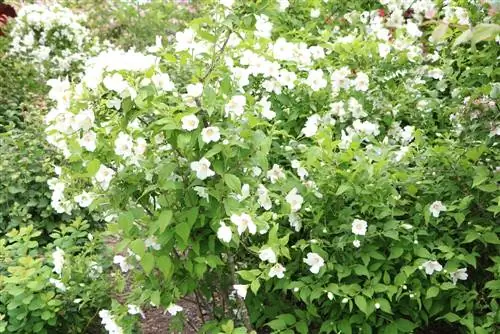
As a rule, the pipe bush is planted in the fall before the first frost. This is the ideal planting time, especially for bare-rooted bushes or commercial bales. But if you have purchased the expensive version in a container, you can also use the shrub at any other, frost-free time. When planting, the main thing to remember is that the roots of the shrub want to spread unhindered; this is a heart root system. Therefore, a large planting distance from the side shrubs in a hedge must be maintained. But since the garden jasmine also grows widely above, the hedge becomes nice and dense even with a larger planting distance. When planting, you should therefore pay attention to the following:
- Dig up and prepare soil
- Planting hole should be twice as big as the root ball
- Water the roots well by placing them in a bucket of water
- create drainage at the bottom of the planting hole
- Insert the bush and fill in prepared soil
- press well and pour
- Give up mulch so the soil stays moist
- Short shoots by about a third
- how to support lush branching
If the pipe bush is not planted as a solitary plant on a large meadow or in the front garden bed but is cultivated in a hedge, then in the row you should ensure a minimum distance of one meter between two planting holes from edge to edge. This gives the roots enough space to spread. Since the shrub grows up to two meters wide, the hedge becomes very dense despite the large planting distance.
Cultivation in a bucket
If there is no garden, the stuffed garden jasmine can also be cultivated in a pot so that it can beautify the balcony or terrace. But because of its lush roots, a very large pot must be chosen. However, a pipe bush cultivated in a pot often retains its flowers and growth. If you still want to try it, you should proceed as follows when planting in the bucket:
- Choose a bucket with a circumference of at least 1.5 to 2 meters
- create a drainage over the drain hole
- Use pottery shards or stones and plant fleece on top of this
- fill in some of the prepared soil
- In addition to garden soil, potted plant soil can also be used
- Insert bush in the middle
- fill in the remaining soil and press down well
- pouring
- shorten the shoots by a third here too
Repotting
Repotting is quite difficult due to the size of the garden jasmine's roots. It therefore makes more sense to choose a pot large enough when planting for the first time. The soil in the pot can then be replaced regularly every two or three years to improve supply, but the plant can remain in the pot as a whole.
Cutting
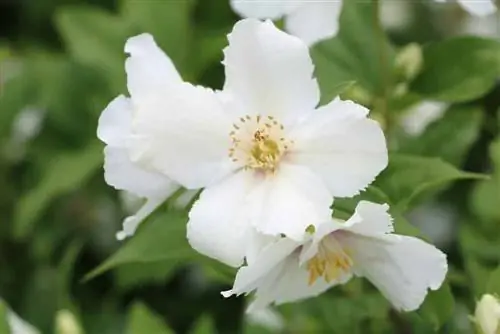
Pruning the graceful pipe bush is not necessary. If you have a lot of space and the garden jasmine was planted as a solitary plant in a large meadow, you can simply let the shrub grow lushly. The cut says nothing about the flowering ability. The plant does not usually become bare from the inside, as is the case with many other shrubs. However, if the plant has become too large or if it is used as a privacy screen by a hedge, you should use scissors every now and then. However, it should also be borne in mind that when a main shoot is removed, a flower-bearing branch is removed. A massive pruning can result in the plant producing little to no flowers for the next one or two years.
Appropriate timing
The flowers of the pipe bush are formed in small buds as early as autumn, which remain on the bush over the winter. Therefore, it should be avoided to cut the garden jasmine in spring, because then the buds will be removed and the bush will not bloom this summer. The ideal time is therefore in the summer, immediately after the lush flowering in July. An overcast and dry day should be chosen for the cut. Otherwise the sun could burn the interfaces. When it rains, too much moisture is passed through the interfaces into the plant, which would encourage fungal growth or the penetration of bacteria.
Tool
Disinfected and sharp garden tools should always be used to cut the filled garden jasmine. This means that the interfaces are neither frayed by unsharp tools, nor can bacteria or fungi adhering to the tool penetrate the plant through the interfaces. Pruning shears have proven useful for the heavily woody, older branches, while rose shears are sufficient for the younger shoots.
care cut
With this cut, the bush is only thinned out slightly. Only shoots that are too close together and dried branches are removed from the inside. If the garden jasmine planted as a solitaire has become too large, spreading branches are also cut off.
Rejuvenation cut
When rejuvenating, some old branches are cut off at the root base. This cut should be done annually, but care must be taken not to cut too many branches, otherwise this will be at the expense of the abundant flowers. But this cut also stimulates the shrub to form new shoots from the base.
Cutting the hedge
If the garden jasmine was cultivated as a hedge, it must of course retain a certain shape. Unfortunately, this hedge trimming always comes at the expense of the flowers. It can be assumed that the hedge plants produce fewer flowers than is the case with a solitary plant. But the hedge needs its shape and therefore the hedge trimming should be done as follows:
- all protruding and spreading shoots are cut to the same length
- pay attention to the desired shape of the hedge
- remove one or two older branches at the base of each bush
- remove dead shoots from the inside
- remove shoots that are too close together
Propagate
Anyone who has already cultivated a pipe bush in the garden will want more and more of these graceful and fragrant bushes over time. This means that filled garden jasmine can usually be easily propagated. This is easy to do with cuttings. To do this, proceed as follows:
- best time is summer before flowering in June/July
- choose half-woody head cuttings
- cut to a length of ten to fifteen centimeters
- Remove leaves, leaving only the leaves at the tip
- Fill growing soil into pots
- Insert cutting about five centimeters
- make sure that at least one eye is in the ground
- water well and keep moist
- Put over transparent film to keep in moisture
- ventilate regularly to prevent mold from forming
The cultivation pots are placed in a warm, partially shaded location without direct sunlight. If new leaves appear, then the roots have started and the foil should now also be removed. If the small bushes have developed well by autumn, they should still be protected for the first winter in a cold but frost-free place, which can also be semi-dark. The plants grown from the previous year's cuttings are transplanted to their final location the next spring after frost. However, if pipe bushes are propagated from cuttings themselves, it can take up to two years for the first flowering.
Tip:
By propagating through cuttings, the hobby gardener always receives the same shrub as he has already cultivated in the garden.
Sowing
After flowering, the double jasmine develops capsule fruits that can be used for sowing. Single-variety seeds can also be purchased from well-stocked garden shops. When sowing, you should proceed as follows:
- Harvesting capsule fruits in autumn
- let dry in a warm, dry place over winter
- The sowing takes place in the spring
- Remove seeds from the dried fruit
- fill small pots with potting soil
- Press seeds lightly
- Keep soil moist
- Put transparent foil over the pot
- ventilate regularly
- place in a bright and warm place without direct sunlight
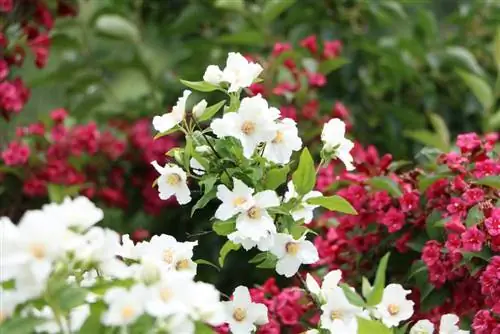
When the first strong seedlings appear, the foil is removed, the seedlings are pricked out and placed in their own, slightly larger pots. Here the small plants can develop in a protected, bright and warm place without direct sun over the summer. It must be watered regularly and the soil must always be slightly moist. In the fall before the first frost, the pots with the young plants are moved to a cold, frost-free location. Next spring they will be ready to be planted out in the garden bed to their final location.
Tip:
Since it has still not been possible to determine with certainty whether the double jasmine is poisonous or not, the fruits of the bush must under no circumstances be consumed. Non-toxic varieties have now been bred, but there are still fears that the decorative plant may be slightly toxic.
Wintering
The stuffed garden jasmine is completely hardy when it gets old and no longer needs to be protected from frost. However, in the case of potted plants, the pot should be provided with winter protection, as the roots are more easily exposed to the cold. The following should be taken into account when wintering:
- the shrub is deciduous in winter
- puts the buds back on in autumn/winter
- Protect in the first one to two years after planting
- add a layer of mulch or brushwood to the ground
- cover the bush itself with plant fleece
- cover a pot entirely with brushwood mats
- place in a protected place in front of a wall or in a corner
- Place the bucket on Styrofoam or a thick wooden board
- Cover soil with mulch or brushwood
- only cover the young plant with plant fleece
As soon as the pipe bush is two years old, the plant itself does not need winter protection made of plant fleece, neither in the pot nor outdoors. However, the soil and the pot should continue to be protected over the winter by taking the measures mentioned above.
Conclusion
Caring for the pipe bush is incredibly easy because it requires little attention. This means that it only needs to be watered and fertilized a little, and cutting should not be too heavy. Beginners among hobby gardeners can also successfully propagate this graceful plant. Once it has been planted in the right location, it will show itself in all its glory every year without the hobby gardener having to put in much effort. This makes it the ideal plant for anyone who doesn't have much time to care for their garden, but still wants lush flowering shrubs and plants.

